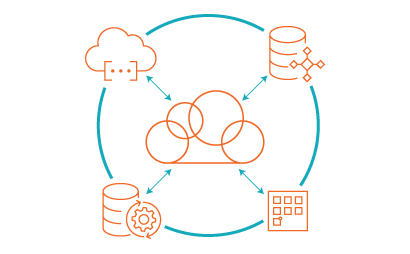Learn how cloud data management supports business initiatives by driving innovation, increasing productivity, and reducing costs.
What Is Cloud Data Management?
Cloud data management is the implementation of cloud data management platforms and tools, policies, and procedures that give organizations control of their business data, both in the cloud and in setups where data is stored or sourced in a combination of on-premises and cloud applications.

Increasingly, organizations are realizing the value of migrating workloads to the cloud, taking advantage of the cloud’s agility to optimize new products and services and to reduce CapEx and OpEx. As enterprise businesses continue to shift IT operations and applications to the cloud, there is a vital, strategic need for cloud-centric data management tools and platforms that can manage all types of data.
How Does Cloud Data Management Differ from Traditional Data Management?
Traditional data management tools work well for on-premises workloads but tend to struggle when cloud-based workloads are involved. One way to make data management tools cloud-centric is by developing them as cloud-native—meaning they are architected to run in the elastic and distributed nature required by modern cloud computing platforms.
Other key tenets of cloud data management platforms (also known as cloud lakehouse data management platforms) include:
- They can support data across various cloud ecosystems (multi-cloud).
- They are API-driven and delivered as microservices.
- They use modern constructs like containers and serverless for faster and scalable deployment.
- They are simple to install and set up.
- They are easy to manage, with automatic upgrades and patch management.
- They are priced based on service utilization.
Six Key Capabilities for Data Management in the Cloud
As organizations plan out or rework their data architectures in response to changing business requirements and processes, cloud data management should be a top consideration. Here are six important capabilities to consider when creating your cloud data strategy:
1. Cloud Integration
The cloud can drive innovation, uncover efficiencies, and help redefine business processes. But you can only achieve these benefits when your cloud infrastructure allows you to integrate, synchronize, and relate all data, applications, and processes—on-premises or in any part of your multi-cloud environment.
At a more granular level, businesses may be looking to design, run, and automate business processes that span applications. They might want to integrate applications in real time using orchestration, APIs, and messaging, or run extract transform load (ETL) batch integration jobs for their analytics platforms (cloud data warehouses and data lakes) or to keep application data synchronized.
For these situations, organizations need intelligent data and application integration and API management tools, as well as a broad set of connectivity capabilities—all of which form the core components of a modern integration platform as a service (iPaaS). Learn more about what you need for a comprehensive iPaaS.
2. Cloud Data Quality and Governance
As companies put data at the heart of their business processes, the most successful organizations recognize the role of high-quality, trusted data in their digital transformation initiatives. As this recent survey by McKinsey & Company notes, “Companies that empower employees to consistently use data as a basis for their decision making are nearly twice as likely as others to report reaching their data and analytics objectives.” In addition, data regulations have become increasingly complex and dynamic.
To move their initiatives forward, an organization must ensure that people across the enterprise are able to easily locate, access, understand, and use data. An automated, cloud-based data quality and governance process provides the clean, high-quality data that business and IT users need to quickly realize business value.
3. Cloud Data Privacy and Security
With the rise of cloud, data is becoming more exposed to the possibility of abuse and attacks beyond the traditional firewall. Protecting your data, managing safe access, and enforcing compliance and appropriate use policies to reduce the risk of security breaches and corporate abuse is not just business-critical—it’s now the law.
Privacy assurance helps you democratize safe data use, accelerate and unblock cloud workload migration, and deliver innovative products and services that build on customer trust. Integrated cloud data privacy and protection tools can help you:
- Automate discovery and classification of sensitive data.
- Map identities for clear ownership and support data access rules.
- Operationalize privacy policies.
- Model and analyze data risk exposure across data stores and locations.
- Orchestrate data protection.
An integrated approach to cloud data privacy based on metadata-driven intelligence and automation helps you take quick action by providing data use transparency, protecting personal information with data masking, and monitoring for the effectiveness of controls in place for audit reporting.
4. Cloud Master Data Management
With all the data being generated across business lines, you need a complete, 360-degree view of any domain and any relationship in the cloud. Furthermore, there is a push for intelligent data stewardship and improved search and visualization of data, as well as improved verification and enrichment. Cloud master data management (MDM) capabilities synchronize the most critical data across various systems in your organization into a single, validated record, enabling AI and analytics teams to derive deep insights from that data to power your business. Read about best practices for cloud MDM.
5. Cloud Metadata Management and Data Cataloging
All business transformations depend on good, trusted data. But as the data landscape grows more complex, diverse, and distributed, across many different departments, applications, data warehouses, and data lakes (some on-premises, others in the cloud), it becomes difficult to know exactly what data you have, where it resides, and how best to manage it.
By leveraging a combination of technical, business, operational, and usage metadata, intelligent data catalogs help build a robust data foundation to support cloud modernization, data governance, and other business priorities. A comprehensive enterprise data catalog solution uses machine learning-based data discovery to scan and catalog data assets across the enterprise and provide analysts, data scientists, and IT users with powerful semantic search, detailed data lineage, profiling statistics, data quality scorecards, holistic relationship views, automated data curation, crowd-sourced data curation, and much more.
6. AI-Driven Enhanced Intelligence
Modern cloud data management platforms provide AI capabilities that allow you to:
- Automatically discover and catalog data across various systems such as ERP, CRM, and so on.
- Automatically discover relationships between customer data and match insights to specific people.
- Automate data integration and data quality tasks, intelligent policy management and enforcement, and more.
Learn more about how Informatica’s machine-learning based innovations help improve data management outcomes.
The Value and Benefits of Cloud Data Management
As the modern enterprise becomes more cloud-centric, and new sets of data users (business analysts, data scientists, ad-hoc users, etc.) emerge, it is imperative to have the right tools and processes in place to manage all that data.

Cloud data management spans the end-to-end lifecycle of data, from creation to retirement, and the controlled progression of data through each stage of its lifecycle. It helps minimize the risks and costs of regulatory noncompliance, legal complications, and security breaches. It also provides access to accurate data when and where it is needed, without ambiguity or conflict, thereby avoiding miscommunication.
With the right cloud data management strategy and tools in place, you can realize several core benefits:
- Enhanced analytics through improved integration and ingestion.
- Improved data security and data governance posture.
- Improved data quality to avoid the “garbage in, garbage out” problem.
- Rapid data discovery and enhanced metadata management.
- Optimized records maintenance and management across systems—attaining the “golden record”.
Example Use Case: Modernization with a Cloud Data Warehouse or Lakehouse
Adopting cloud data warehouse (CDW) systems to improve analytics is a key digital modernization initiative. CDWs offer a plethora of benefits over traditional data warehouses, such as enhanced scalability and elasticity, flexibility and agility, faster time to value, and better performance.
The right cloud data management tools can aid and accelerate the process of migrating workloads from an existing on-premises data warehouse to the cloud or building a new cloud data warehouse:
- Discovering the right data:You want to find and migrate all the relevant data to the new CDW. Is there data in another cloud application such as Salesforce that would be useful? Is there relevant information that exists only on a spreadsheet on OneDrive?
- Integrate data across various sources into the CDW: The data in your cloud data warehouse will come from a rapidly expanding array of sources, each of which has its own data models and format. Potential internal data sources include applications hosted on public clouds like software as a service (SaaS) apps.
- Ensure data quality: If you feed low-quality data into your CDW, you’ll generate low-quality insights. You must manage your cloud data to ensure high quality no matter where the data originated or where it is going.
Without a comprehensive set of cloud data management tools in place to aid with the above, most CDW projects will face stumbling blocks towards seamless operation. Read more about what to consider when embarking on a CDW initiative.
Customer Data Management Success Stories
Avis Budget Group, one of the largest automotive rental groups in the world, uses an intelligent, metadata-driven cloud data management platform to organize fleet and telematics data to provide visibility into data location, lineage, and business context. The company also mitigates risk by improving data quality and governance, helping to ensure that fleet data is complete and in the right format.
A cloud data management platform also enabled JLL, one of the largest professional services and investment management firms in the real estate space, standardize data management principles, access, and other data governance processes for increased consistency and accuracy of data across the enterprise.
Cloud Data Management for Modern Enterprises
An effective cloud data management strategy is a must-have for a modern enterprise—especially as organizations accelerate their adoption of cloud infrastructure, applications, and services. Whether you are moving and synchronizing data across data systems, securing critical organizational and customer data, ensuring high-quality data across systems, or uncovering deep insights into the lineage of critical enterprise data, you need to be able to handle any data requirements across any environment. A platform approach offers a significant advantage as all core capabilities are under one unifying umbrella, sharing a common data model.




